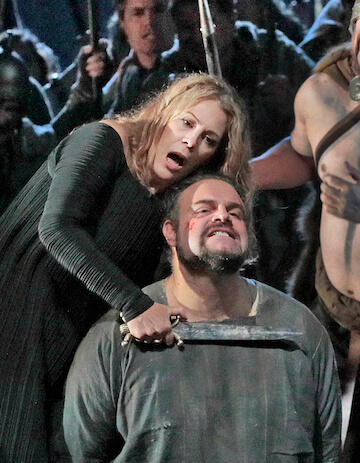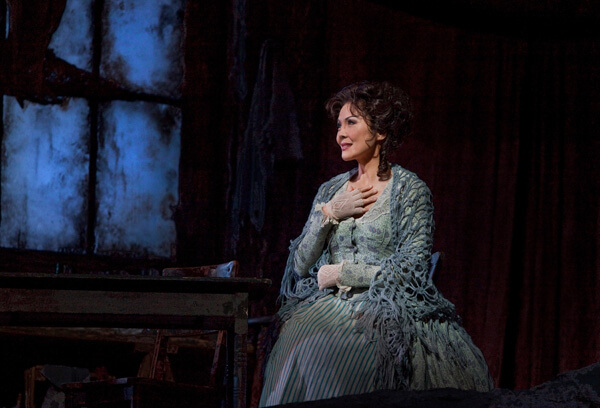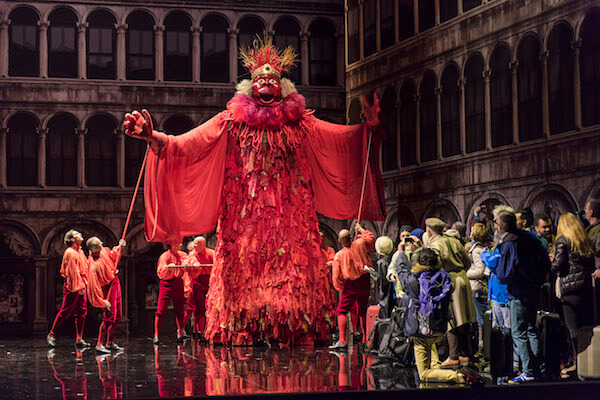David Adam Moore and Amanda Echalaz in the US premiere of Thomas Adès’ “The Exterminating Angel” at the Metropolitan Opera. | KEN HOWARD/ METROPOLITAN OPERA
One of the more adventurous offerings of the Metropolitan Opera’s 2017 – 2018 opera season is the US premiere of Thomas Adès’ “The Exterminating Angel.” The Adès opera, based on Luis Buñuel’s enigmatic 1962 surrealist film “El Ángel Exterminador,” arrived in New York after premiering last summer at the Salzburg Festival with a stop at London’s Covent Garden along the way.
Tom Cairns’ libretto, in collaboration with the composer, smartly condenses the screenplay by Buñuel and Luis Alcoriza combining several characters and streamlining the plot. The revisions are intelligent and aim for clarity without losing the spirit of the original.
The story concerns a group of wealthy Spanish aristocrats hosting a dinner party after the opera. A mysterious inertia takes over this group of the privileged elite and they find themselves blocked by an invisible psychological force from leaving their hosts’ elegant salon. Days and weeks of this strange captivity pass by: food and water runs out, personal hygiene hits crisis level, party guests die under various circumstances. Trapped together by a mysterious invisible force, the one-percenters turn on each other. The final tableau depicts their equally inscrutable liberation into a world that is now threatening and offers no refuge.
Thomas Adès adapts Luis Buñuel’s party at the end of the world
Adès’ score embodies what a friend of mine dubbed “tonality in crisis” — a mixture of the spare lyrical realism of Benjamin Britten heavily spiked with Stravinsky at his most dissonant and cacophonous. Adès is wildly adventurous and imaginative in his orchestration, utilizing exotic instruments like the ondes Martenot (the musical voice of the “Exterminating Angel”), bells, guitar, and piano. In the midst of all this dissonant musical expressionism, Adès drops in musical quotations and allusions — waltzes, baroque sonatas, and Sephardic song for Leticia’s incantatory aria in the last scene. The fragmentary, expressionist style gives the listener a vivid sense of dislocation and disorientation.
I found the first two acts (played without intermission) intriguing but alienating. My problem with Adès’ score is that while in the film the story moves from the comfortably elegant to the disturbingly surreal, the opera starts out dissonant and jarring and has nowhere else to go. Buñuel famously dissuaded critics from suggesting a literal or symbolic interpretation of his film but there is an element of social satire of Franco-era Spain as well as considerable black humor. The composer might have introduced a musical atmosphere of elegant banality with dissonant expressionist undertones gradually emerging and progressively dominating the sonic landscape as the story develops. Adès does not have this kind of light touch and lays on the apocalyptic bells and whistles with the first notes.
In the third act, when the entire cast has been reduced to an almost animal-like “Lord of the Flies” existence, the expressionist brutality of the score really began to score points. Passages of lyrical beauty in Act III — like the love-death duet of the suicidal young lovers Beatriz and Eduardo — function outside of the main musical fabric yet provided dramatic truth as well as musical contrast. A hallucinatory nocturnal “dream” sequence in Act III showed director and composer working together in an inspired fashion.
Librettist Cairns’ production moves fluidly, smartly using the stage turntable to keep the action moving and to change the visual perspective on the elegant salon turned existential prison. Hildegard Bechtler’s sets and costumes lack the luxuriously realistic detail of the film, opting for a modern expressionist style. The physical degradation of the characters was vividly realized as the story progresses.
One continuing problem with Adès compositional style is his penchant for pushing the human voice — especially high women’s voices — into their extreme registers. Adès introduced the party’s hostess Lucía de Nobile (sung by the striking South African soprano Amanda Echalaz) with an ungainly arioso that seesaws from the highest register to toneless low chest, rendering text indecipherable and alienating us from the character. Similarly, coloratura soprano Audrey Luna pipes away in her whistle range incomprehensibly all night long as the opera singer Leticia (slightly less, however, than Luna was obliged to as the stratospheric Ariel in Adès’ “Tempest” at the Met five years ago).
In contrast, lower-voiced singers like the veteran bass Sir John Tomlinson (as the voice of reason Dr. Conde), baritone Rod Gilfry, and the mezzos Alice Coote and Christine Rice provided vocal balm and clear diction all evening. Tenor Joseph Kaiser as the host Edmundo de Nobile overcame the awkward vocal writing, projecting compassion and humanity. The other two tenors, David Portillo and Frédéric Antoun, sounded attractively lyrical. David Adam Moore (who possesses a silent movie matinee idol profile), Sally Matthews, and Sophie Bevan made excellent Met debuts in the roles they created last year at the Salzburg premiere. Countertenor Iestyn Davies sang beautifully and avoided condescending caricature as the overwrought Francisco de Ávila, a character the director-librettist and composer turn into something of a hysterical queen.
Adès himself presided in the pit, giving an interpretation of unquestionable authority that the Metropolitan Opera Orchestra realized with stunning force and detail.
The audience rewarded the composer with a standing ovation at the final curtain call; however several audience members managed to flee this operatic dinner party before it ended. Critics also either loved it or hated it. This critic alternated loving and hating it over the course of the evening but recommends you remain after the intermission.
Two other new operas about people trapped together by accident, circumstances, or their own mistakes were presented in their New York premieres in October.
The New York City Opera presented the New York premiere of Tobias Picker’s “Dolores Claiborne” at 59E59 Theater A in a reduced chamber version. Based on the novel by Stephen King with a libretto by J.D. McClatchy, “Dolores Claiborne” deals only in psychological horrors, not paranormal ones. Picker and McClatchy hew closer to the original novel than the 1995 film in their operatic adaptation, which premiered in 2013 at the San Francisco Opera.
In small town Maine, Dolores Claiborne works as a housekeeper and later caretaker/ companion for the nasty rich widow Vera Donovan. The women hate each other but are bound by shared secrets that involve each woman’s husband and Dolores’ troubled daughter Selena, for whom Dolores would do anything. The opera is framed by the police interrogation of the title character, who is under suspicion of murder, with the rest of the story told in flashback until the final resolution.
Michael Capasso presented a chamber version of Picker’s “Emmeline” at the Dicapo Opera and has directed this production of “Dolores Claiborne” in a similar format for NYCO. For this production, Picker has reduced the orchestra from 70 to 14, eliminated the chorus and minor characters, utilizing only five singers and trimmed the score to focus more closely on the main protagonists. As McClatchy astutely states in his program note, “that has only given the opera a greater, more eerie intimacy.”
Dolores herself is not an immediately sympathetic protagonist — she is foul-mouthed, abusive, defiantly uncooperative, and combative. The brutal marriage, poverty, and hardships that molded her personality are revealed bit by bit as we journey through her past to the present. Much of the opera is structured around brutal one-on-one confrontations — Dolores and the police detective, Dolores and her husband, her daughter and her employer Vera Donovan. Tense dialogues and angry duets dominate the opera.
Moments of lyrical expansion have to be superimposed on the score — such as Dolores’ evocation of the sea sung to Selena on the ferryboat. Otherwise, Picker’s tonal score is lean and punchy, working closely off of the text. Heard in a smaller format in closer quarters, it delivers a greater impact as a kind of American verismo; Picker called the opera an American “Tosca.”
The role of Dolores was written for Dolora Zajick, who withdrew from the San Francisco premiere late in rehearsals and was replaced by the game Patricia Racette, a soprano. Lisa Chavez as Dolores restored to the role the dark, earthy power of a full mezzo-soprano voice giving an honest, uncompromising directness to her interpretation. Lyric sopranos Jessica Tyler Wright as the bitter Vera Donovan and Lianne Gennaco as Selena gave detailed, complex performances in roles much more emotionally demanding than the musical theater, operetta, and comic opera soubrettes listed on their program bios. Thomas Hall as Dolores’ despicable husband Joe St. George didn’t stint on the brutality of the character, while giving a disciplined, well-sung vocal performance displaying a powerful, oaken baritone voice. Tenor Spencer Hamlin was expert as Detective Thibodeau, also revealing a quality voice.
Pacien Mazzagatti conducted an unseen chamber orchestra behind the scenery coordinating with the soloists via closed circuit television. There were no ensemble or musical disconnects that I could detect, a testament to Mazzagatti’s expert rehearsal and coordination of the soloists and orchestra players. The production seemed to me to be one of Capasso’s finest hours — his direction of the principals was spot-on. John Farrell’s simple white set with its two playing areas, staircase, upper level, and central door provided a versatile backdrop for his ingenious scenic projections. This is the sort of work that City Opera should be doing and, thankfully, still is.
Rod Gilfry and Alexander Lewis in Matthew Aucoin's “Crossing” presented as part of the 2017 BAM Next Wave Festival. | RICHARD TERMINE
The Brooklyn Academy of Music presented the New York premiere of “Crossing” composed, written, and conducted by Matthew Aucoin. The work premiered to great critical acclaim in 2015 at the American Repertory Theater in Cambridge, Massachusetts. BAM transported the original ART production to Brooklyn with the principal cast intact as part of the 2017 BAM Next Wave Festival.
Aucoin’s literate original libretto presents a fictionalized portrait of Walt Whitman working as a nurse in a Washington DC hospital for wounded soldiers during the Civil War. Whitman encounters a bitter, physically and emotionally damaged soldier named John Wormley with whom he develops a complicated emotional and later a physical bond. Wormley lashes out at the gay poet and then demands his love, which he later rejects. Betrayal lies beneath the surface as well as genuine human need. Whitman, after spending a night of love with John, learns that he is a Confederate rebel who has betrayed the location of the hospital to his Southern allies.
Aucoin states that his Walt Whitman is a fictional creation inspired by Whitman’s poetry and prose. One problem with Aucoin’s libretto is the poetic diction given to all the characters, not just Whitman, who speak in a uniform literary fashion incongruous with their level of education or intellectual sophistication. In the program notes, Aucoin extols the musical landscape of Whitman’s poetry but his use of the human voice remains earthbound — poetry in music is melody and that is lacking throughout. Passages of Whitman’s poetry are set to music yet the one does not elevate the other.
A vocal solo by the freed black slave turned Union soldier Freddie Stowers is modeled after a Negro spiritual but only achieves disjointed spurts of melody before meandering into tuneless parlando. The male choruses and orchestration have points of interest, revealing Aucoin’s debt to Philip Glass, John Adams, and Aaron Copland. Otherwise, his opera spoke at length aiming at poetry but seldom sang. It all felt like a worthy academic exercise; not a living, breathing musical drama.
On the other hand, as theater this was a worthwhile evening. The two male leads, the ensemble of 11 singers, and Jennifer Zetlan’s lone female voice as the soprano Messenger delivered sensitive, vibrant performances. Rod Gilfry, nearly unrecognizable under a grizzled gray beard and shaggy hair, gave Whitman depth, compassion, and humanity; his warm baritone sounded appropriately weathered but soothing. Gilfry’s English diction was 100 percent comprehensible, making each word believable and connected to the reality of the character.
As the sensitive but damaged John Wormley, the multi-talented Australian tenor Alexander Lewis displayed highly developed theatrical skills and virtuosic physical acting honed during his years as a musical theater and dramatic actor. His lean lyric tenor is short on lyricism and his characterization stressed the wild-eyed angry misfit qualities of the character. One wondered what John’s appeal was for Whitman to fall so deeply in love with this particular soldier on such short acquaintance — especially with so many other attractive male specimens onstage to choose from.
Director Diane Paulus gave the work a superbly unified production full of enlightening details and well-observed interactions. Tom Pye’s scenery, David Zinn’s costumes, and Jennifer Tipton’s lighting created a brooding, stark universe. The chamber orchestra, A Far Cry, played masterfully under the baton of the composer. “Crossing” was a musical journey that had high and noble artistic goals yet fell short of achieving its ends. Still, Aucoin is young and full of ideas and the right ones. I look forward to seeing more of his work.
“The Exterminating Angel” will be transmitted internationally in HD on November 18 at 12:55 p.m.; visit metopera.org/Season/In-Cinemas/Theater-Finder for participating movie theaters.




































